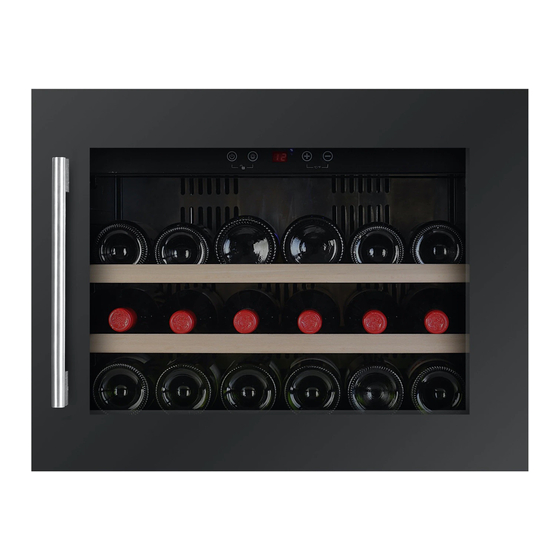Dunavox DAB-18.55B Manuel d'instruction - Page 7
Parcourez en ligne ou téléchargez le pdf Manuel d'instruction pour {nom_de_la_catégorie} Dunavox DAB-18.55B. Dunavox DAB-18.55B 15 pages.

may vary. The maximum storage number is based
on standard 0.75 litre Bordeaux style wine bottles.
Storing Your Wines
The chart
below
indicates
temperatures for different types of wine:
Type of wine
15.5 – 18.5°C
Red wine (*)
10 - 15°C
White wine
(**)
Sparkling
wines/
7.2 – 9.5°C
Champagne
9.5 – 10.5°C
Rose wine
Vintage wine
* Light red wines, such as Beaujolais, Pinot Noir and
Cabernet Franc benefit from being served slightly
cooler than full-bodied reds.
** Chardonnay is often served too cold. You should
chill it at a warmer temperature inside of your Wine
Cooler. Or leave it to warm slightly when you
remove it from your Wine Cooler.
•
Temperature stability is the most important factor
when it comes to storing wine.
•
Exposure to light, vibrations or fluctuations in
temperature and humidity can all cause wine to
spoil. When properly stored, wines not only
maintain their quality but many will actually improve
in aroma, flavour and complexity as they mature.
•
Wines kept at a higher temperature will age faster.
Wine that is exposed to temperatures that are
greater than 21°C (70°F) will suffer from poorer
flavour and aroma.
•
If wine is kept at too low a temperature, this can
result in the development of harmful deposits. A
humidity of 70% is ideal for keeping corks from
shrinking.
the ideal
storage
59.9 –
65.3°F
50 – 59°F
45 – 49.1°F
•
After a bottle of wine has been opened, the wine
comes into contact with air. So it is best to store the
remainder of the bottle upright, to minimize the
surface area of the wine that is coming into contact
with the air.
•
Once opened, wine will remain in a drinkable
condition for two days for delicate whites or three
days for rich reds, as long as the bottle as been
resealed. You should make sure that the seal is firm
by checking the stopper.
•
Special stoppers that keep wine sparkling and
Champagne bubbling for one or two days after
opening, can be bought at most good wine shops.
•
When stored correctly, white wines can keep well
for up to two years. Full bodied reds will age well for
ten years and dessert wines will age well for up to
twenty years.
•
When you buy a bottle of wine, you should transfer
it to a suitable storage location immediately (if you
are not going to store it in your Wine Cooler). o
Cheaper bottles of wine will not age as well as more
expensive ones.
•
To make the most of the bouquet and taste of your
wine, never fill more than half a glass at a time. It
will also help if the shape of your wine glass is
appropriate for your wine. The size and shape of
your wine glass's bowl will determine the intensity
and complexity of the bouquet. The stem should be
long enough to allow you to avoid hand contact with
the bowl of the glass and should be tulip-shaped or
tapered at the top.
Wine Storage Problems
Corking-
a tiny percentage of bottled wine (about
1%) will suffer from this. The cork reacts with the wine
and gives it a musty, unpleasant taste. It is the most
common wine storage problem and is caused by
harmless bacteria growing on the cork. As unfortunate
as this is, there is nothing to do but to discard all of the
wine in the affected bottle. This is not to be confused
with small fragments of cork floating in the wine itself,
which will not impair the flavour.
Oxidisation-
when wine has been opened and left
for longer than a day; it tends to lose its aroma and
colour, giving an overall flat taste. The only way to
avoid this, it to either drink the wine on the same day
it was opened or to use a vacuum device specially
designed for removing oxygen from opened wine
bottles. If you use such a device, the wine should still
be consumed shortly afterwards.
Ullage-
this is loss of wine from the bottle by
evaporation or leakage. Signs of ullage include wine
seeping around the cork, a protruding cork or a stained
label. It can happen if the bottle has been allowed to
get too warm. The wine may still be drinkable, if the
leakage was recent; however, you should be aware
that if the wine cools down again, contraction can
